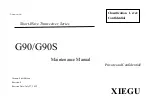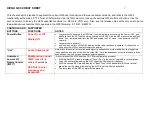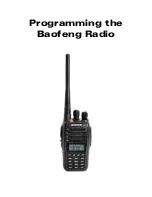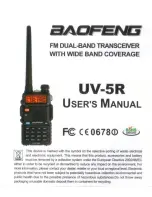
TIMTER™ Multi-mode Digital Telemetry Transmitter
76
Quasonix, Inc.
4.
Turn the soft RF control on using
RF 1
.
5.
Disable the internal clock source with
CS 0
. This is the normal state on power up for most units.
6.
Disable the internal data source with
DS 0
. This is the normal state on power up for most units.
7.
Be sure that a clock source is connected to the correct pins of the transmitter input connector with the
correct type (TTL or RS-422) of signal and in the case of RS-422, the correct polarity.
8.
Be sure that the clock source is ON and that the clock rate is within the allowed range for the mode
selected. Typically this is 100 kbps to 28 Mbps for Tier 1 and 2 waveforms and 50 kbps to 14 Mbps for
Tier 0.
9.
Be sure that a data source is connected to the correct pins, with the correct type (TTL or RS-422) and
polarity as above.
10.
Use a spectrum analyzer to verify the desired waveform on the RF output at the desired frequency.
11.
If the waveform is NOT present, check the state of the RF On/Off pin. Use the
RZ
command to check the
current polarity of the RF On/Off pin.
•
RZ 1
sets the transmitter output to turn ON when the RF On/Off pin is high (3.3 VDC).
•
RZ 0
sets the transmitter output to turn ON when the RF On/Off pin is low.
12.
Change either the RF On/Off pin or the polarity to turn the RF output ON.
You may issue the RF command and observe the status which is returned. This status indicates whether the
transmitter believes the RF output is actually ON or not.
The
SY
command may be issued to check the actual clock rate that the transmitter sees if no RF output is detected.
One of the most common problems is a clock rate that is too high or too low (or missing) for the desired modulation.
Finally, if you have a full RF loop running with a BERT and are having trouble achieving a zero bit error rate or
lock, try the loop using internal data with the standard PN15 bit pattern. Be sure the BERT pattern is set to match the
selected data pattern (
ID
command) on the transmitter. Assuming the internal data syncs and produces a zero bit
error rate, you can switch back to the external clock and data. In this case, you can also check (and change) the clock
polarity (
CP
) the data polarity (
DP
), the randomizer (
RA
), and the differential encoder (
DE
– normally on for
SOQPSK and off for other waveforms) to resolve the sync and bit error rate issues.
If you are still having difficulties at this point, then contact Quasonix technical support.
Quasonix Technical Support
(1-513-942-1287) or email ([email protected])
When calling technical support, it will speed things up if you have the following information handy:
•
Model number (obtained with the
ZZ
command) ***Note that this is different from the customer part
number.***
•
Serial number (obtained with the
SN
command)
•
Software Version (obtained with the
VE
command)
It is also helpful if you can call from a phone in your lab so our tech support people can actually walk you through
setting, checking, and controlling your transmitter).
Содержание TIMTER QSX-V Series
Страница 39: ...TIMTER Multi mode Digital Telemetry Transmitter 31 Quasonix Inc Figure 22 Baseband Signal Timing ...
Страница 101: ...TIMTER Multi mode Digital Telemetry Transmitter 93 Quasonix Inc Figure 41 Shock Pulse X axis Negative ...
Страница 109: ...TIMTER Multi mode Digital Telemetry Transmitter 101 Quasonix Inc Figure 42 Transmitter Clock and Data Logic ...
















































